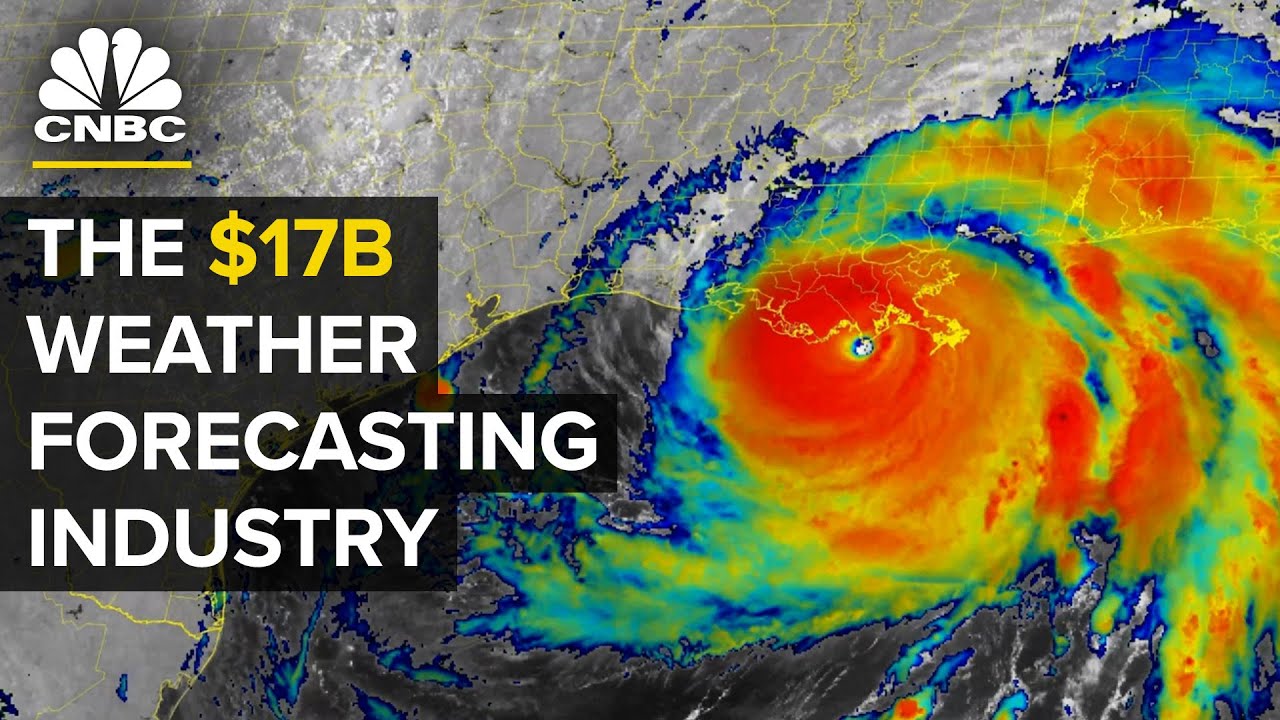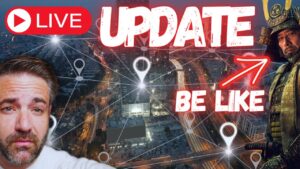As climate change
intensifies extreme Weather, accurate
forecasting is becoming More imperative than
ever. The US experienced 18
separate weather or Climate disasters in
2022 alone, costing a Total of $165 billion in
damages. The disasters were also
deadly, causing at least 474 direct or indirect
fatalities. Tracking weather and
disseminating forecasts In the US has
historically been the job Of government agencies
like the National Oceanic And Atmospheric
Administration or NOAA. But as climate change
makes weather disasters Deadlier and more
expensive, a new Generation of private
companies has cropped up To provide paying
customers with Hyperlocal,
hyperspecific weather Forecasting. What Tomorrow is trying
to do is to help Customers, either
countries or businesses, Manage their
weather-related Challenges by giving
them weather intelligence Software. Software that
tells them exactly what To do in relation to
their job and their Industry. The weather forecasting
services industry in the US was estimated to be
worth $17.4 billion in 2023. The economic value of the
forecast has always kind Of far exceeded how much
it costs to produce. But in an era of climate
extremes, that becomes Even more true. Which is
also why you see a lot of The impulse towards
private companies to Capitalize on that.
In an effort to get ahead
of severe weather, NOAA Is also increasingly
turning to private Partnerships. The
organization already Works with the private
sector to build some of Its infrastructure, like
weather satellites and The supercomputers that
it uses to generate Forecasts. Now, NOAA is
exploring buying weather Data as a service. It's an effort that
gained momentum in 2017 With a new law that
encourages the private Sector to generate
weather data that the Government can use to
beef up its forecasts. Society's needs for
actionable and Intelligible weather and
environmental information Is growing at such a
rapid pace with the Number of billion dollar
disasters and the Duration between them
growing shorter for any One entity to meet
alone. Private weather companies
are likely here to stay, Leading some to wonder
how those who can't Afford their services
will be affected. Weather forecasting has
come a long way from its Humble beginnings, when
volunteers would send Weather reports from all
over the country by Telegraph to the
Smithsonian Institution In Washington, D.C.,
which generated a National weather map. Meteorologists kind of
improved their Understanding of the
atmosphere, you know, in The sort of 100 years
between those initial Telegraph forecasts and
World War II. Beginning in the 1950s
and 60s with computers And satellites, up until
today, you have this Incredible improvement
where for kind of every
Decade, the weather
forecast improves by a Day. So today's five-day
forecast is as good as The three-day forecast
was 20 years ago. In the US, the National
Weather Service, which is Part of NOAA, releases
about 1.5 million Forecasts and 50,000
warnings each year as Part of its mandate to
protect life and Property. One part of
the NWS is made up of Local offices, which are
in charge of day-to-day Weather forecasting and
issuing severe weather Warnings to their
communities. The other Part is made up of
national centers such as The National Hurricane
Center, which focuses on Tracking hurricanes and
tropical cyclones, and The Storm Prediction
Center that focuses on Tracking severe
thunderstorms, tornadoes And wildfires. Weather forecasting is an
immense task that begins With collecting more
than 6.3 billion Observations per day of
metrics like temperature, Wind speed and moisture. Over 95% of these
observations come from Satellites. But weather
balloons, ground-based Weather stations,
ground-based radar and Buoys all contribute. NOAA also shares and
pulls observation data From foreign
governments. All this Information is fed into
powerful supercomputers That can each crunch a
quadrillion calculations Per second to produce
weather models, which are Basically numerical
representations of the Atmosphere that
meteorologists use to Come up with forecasts. We can forecast weather
skillfully, which means
That when we put out a
forecast, it would be More informative than
just regurgitating the Average conditions on
that particular day out To about 7 to 8 days. Beyond that, it's a
little more challenging. There's always going to
be some imprecision and Some error in our
current picture of the Atmosphere, and that's
because we don't have an Actual observation of
what the atmosphere is Doing at every single
point on the ground or Every single point in
the atmosphere. So there's some
assumptions being made And those small errors
grow with time as you Project them out in
time, using things like a Computer model. In 2022, NOAA began to
use two new Supercomputers made by
General Dynamics Information Technology,
which the agency says Will allow it to make
more detailed forecasts Further in advance. NOAA also makes its data
sources and models Available to researchers
through a number of cloud Providers, including
Google, Microsoft, Amazon And IBM. Despite all the
high tech sensors and Supercomputers,
meteorologists still play A crucial role. They
generally will look at Several different
weather models and weigh The different outcomes
against one another to Come up with the most
likely forecast. It's a highly
collaborative process, With organizations
routinely exchanging Observation data with
their counterparts in Other parts of the world
that can help to inform Their own weather
models.
It's part of our core
mission to cooperate with Other countries to bring
that vital data in for Our global models. Those global models turn
into local forecasts. Two of the most
well-known global weather Models are the Global
Forecast System, run by NOAA, and a European
model run by the European Center for Medium-range
Weather Forecasts, an Organization made up of
over 30 European Countries. But whereas
NOAA makes its weather Data available for free,
the ECMWF charges for Some of its data. On
average, the European Model has produced more
accurate weather Forecasts than the US
model, though experts Point out this doesn't
mean that the European Model will outperform
the US one on every Storm. The accuracy of
the two models became a Huge point of contention
in 2012 after the European model predicted
that Hurricane Sandy Would slam into the East
Coast days before the US Model eventually came to
the same conclusion after Originally predicting
that the hurricane would Drift into the Atlantic. In some cases, computer
models may not Necessarily capture the
full intensity of the Event. They may hint
that a blizzard is Possible, and sometimes
the most intense Conditions are in very
localized areas. So if you think back to
the pre-Christmas Blizzard in Buffalo, New
York, in 2022, that Blizzard itself was a
very, very localized Area, but obviously very
extreme. They had about 36 hours
of blizzard conditions, Gusts over 70mph.
And so that poses
challenges in really Trying to dial in the
exact area that's going To get the most extreme
conditions. Recent years, NOAA has
provided a lot more High-resolution modeling
that's really helping us Dial in these types of
situations. To help foresee localized
extreme weather events, NOAA is increasingly
turning to the private Sector. The private sector is
very adept at tailoring Products and reaching
niche markets that The Weather Service is not
able to provide support To. Private weather
forecasting is not an Entirely new concept. Companies like
AccuWeather and The Weather Company, which
was purchased by IBM in 2016, have been around
for decades. These companies have
taken the free, raw, Weather data from NOAA
and other government Agencies, repackaged it
into a digestible format Using their own
proprietary algorithms And distributed it to
customers. Some of these Private weather
platforms have also Collected their own
supplemental weather Data. But newer
companies are taking Private weather
forecasting a step Further, not only
telling customers what to Expect, but how to
respond. Founded in 2016,
Boston-based startup Tomorrow.io is in the
business of offering its Clients extremely
detailed weather Predictions and
pre-storm strategy plans Based on its proprietary
algorithms and data.
This can include things
like warning a trucking Company of an oncoming
thunderstorm so that it Can send out its fleet
earlier, or helping tech Companies like Uber with
more accurate ETAs. Most businesses do not
have anything in place to Manage weather and
climate related Challenges, and if they
have something, it's Usually talking to a
meteorologist over the Phone, which is not a
scalable solution. The company says its data
is more accurate than Information the
government can offer. I can 100% guarantee,
looking at our historical Data over the last few
years that on average our Models are more accurate
in between 10 to 40% than Government models, not
only the American models, Also the European model. Tomorrow.io's customers
span a wide number of Industries from airlines
for whom precise weather Data can serve to help
them make decisions such As whether they need to
de-ice planes, to sports Organizations that can
use Tomorrow's Predictions to schedule
events. Technology companies,
utility companies and Government organizations
are also clients. Tomorrow.io has also
worked with a number of Cities, including ones
in New Jersey and Massachusetts, to help
them prepare for incoming Storms. A state may want a very
tailored, specific Forecast for a road. And so because our
information is public Good and publicly
available, the private Sector can take our
information and our Models and our
forecasts, and they can
Innovate on them and
make pinpoint accurate Forecasts. They can
advise on particular road Conditions, closures,
what it means for local Officials. In addition to using
government data, Tomorrow.io initially
gathered weather Information from devices
like car temperature Sensors, windshield
wipers and the signal Strength of cellular
networks, which tends to Be lower when it's
raining. But the company Says it's moving away
from this strategy in Favor of space-based
observations. The idea is to launch a
constellation of 30 Radar-equipped
satellites into space by 2024 to gather weather
data from every point on Earth. Last year, NOAA
announced that it was Partnering with
Tomorrow.io to see how The company's hyperlocal
satellite weather data Might be used to inform
NOAA's weather models. According to the agency,
the agreement is Exploratory and unpaid. Radars are the most
important weather Sensors. They tell us
where it's raining in Real time, how the
clouds look like and Whatnot. And right now,
5 billion people do not Have radar, which means
that in those places, you Don't even know where
it's raining in real Time. I'm not even
talking about the Forecast. You don't have
flood alert. You don't have farmers
insurance. The GDP is correlated to
that and it's lower. Customers pay anywhere
between $20,000 per year To millions of dollars
per year for Tomorrow.io's services,
according to Elkabetz.
Our hypothesis for
Tomorrow is that climate Security is going to be
very similar to cyber Security. If you're not
going to put systems in Place to manage your
weather and climate Risks, you're going to
be held accountable for Not doing everything in
your power to protect Your assets, your
customers, your top line, Your bottom line. Founded in Alameda,
California about ten Years ago, Saildrone is
another private company In the business of
gathering and selling Hard-to-obtain weather
data. But unlike Tomorrow.io, Saildrone
is targeting the ocean. To do this, Saildrone
has a fleet of nearly 100 Unmanned surface
vehicles that it calls Explorers. The company
does not sell the Vehicles themselves, but
rather the data they Collect. Each is
outfitted with a number Of different sensors
that it uses to gather And transmit real time
measurements on metrics Including salinity, wind
speed and direction, air Temperature, sea surface
temperature, humidity and Barometric pressure. All
variables that can be fed Into weather models to
improve forecasting. In terms of the ocean's
role in weather, there is A ton of interaction
that happens between the Surface of the ocean in
terms of heat transfer And energy transfer
between the oceans and The atmosphere and that
interaction, that is Where weather systems
garner a lot of their Energy. One of the most
important ocean weather Phenomena that Saildrone
is helping forecasters Track are El Niño and La
Niña. Things like El Niño, La
Niña, the North Atlantic
Oscillation, or NAO,
longer term patterns like That will tend to affect
weather over the course Of an entire season or
an entire year. So, for instance, you
might say in El Niño, the Water temperatures in
the tropical Pacific Ocean are warmer than
normal. On average, you Can expect wetter
conditions in California And the West Coast and
places like that. It doesn't mean that on
a particular day that You're going to get a
storm system or that a Particular storm system
is made possible because Of El Niño. It just
loads the dice towards Certain outcomes in
certain areas of the World. Saildrones have also been
very useful in tracking And observing
hurricanes, a task that The company has
undertaken in partnership With NOAA for hurricanes
like Sam in 2021 and Fiona in 2022. Data gathered from
saildrones will help NOAA With one of the biggest
challenges in hurricane Forecasting, predicting
rapid intensification, When hurricane wind
speeds increase at least 35mph over a 24 hour
period. In the past, human
hurricane hunters and Buoys gathered much of
this data for NOAA. But Saildrone allows the
agency to gather data From parts of the
hurricane that are too Dangerous for people to
fly into or areas that Are not covered by their
buoy system. NOAA has also used
Saildrone to collect fish Population data and map
the ocean floor. Nearshore surface
mapping, knowing the Depths of the oceans,
knowing where the shelves
Are helps with
forecasting floods and Coastal inundation. So
there's some big efforts That we are looking to
take part in Florida to Better map the coastal
areas there to help Inform flood inundation
and flood forecasting. To accomplish these ocean
mapping missions, Saildrone has two larger
models of its vehicles That can be equipped
with sonar. Like Tomorrow.io,
Saildrone has customers Beyond NOAA, including
the US Navy, Customs and Border Protection and
the US Coast Guard, which Are using the drones for
surveillance. Saildrone declined to
comment on the cost of Its services, but
customers reportedly pay Around $2,500 for a day
of saildrone data. While public private
partnerships can provide NOAA with valuable data
to improve its forecasts, Some worry about a
future where NOAA and the Public become overly
dependent on private Weather companies. The advantage of
privatizing it is you get All the force of private
innovation. More accuracy, and
better decisions, and Better observations, and
better satellites, and Better supercomputers
and all those things. What you're doing,
though, is you're Immediately setting up
the situation where People who can pay for
forecasts are at less Risk or safer than
people who can't pay for Them. And in an era of
climate extremes, when You're talking about
evacuations, when you're Talking about
hurricanes, when you're Talking about, you know,
deadly snowstorms, you Really have a kind of
climate dystopian
Situation where, you
know, rich people are Getting out of the way
of the weather, way ahead Of poor people. But Elkabetz says there's
room for both. If we waited for the
government to develop a Covid-19 vaccine, it
would have been a Disaster. The government
cannot, in our age, be Responsible for
developing innovative Technology. There is a
way to build innovative And great technologies
and also benefit the Public. Draggon agrees that
private public Partnerships will likely
do more good than harm as Long as NOAA remains
steadfast in its mission To serve the public
good. The private industry for
the weather community is A rapidly growing market
and the taxable revenue From that industry goes
right back into the Economy and helps to
fund public entities such As the National Weather
Service. There's data Sets that are absolutely
essential for numerical Weather prediction and
getting that forecast Down to the local level. That has to remain as a
public good. But there's additional
data that can help Increase the accuracy of
those models and help Make the local context
very granular. And that's where perhaps
there's more space to Explore data buys.





